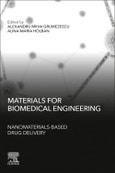Materials for Biomedical Engineering: Nanomaterials-Based Drug Delivery highlights the progress made in the field of nanostructures bioactive materials and their impact on efficient drug delivery towards personalized medicine. Drug delivery is a well investigated and challenging bio-medical field, with promising perspectives in medicine and engineering. This book brings together the latest research findings regarding nanostructured materials and their potential in designing highly efficient and personalized drug delivery systems.
Please Note: This is an On Demand product, delivery may take up to 11 working days after payment has been received.
Table of Contents
1. Superiorities of nanoscale materials in drug delivery2. Three-dimensional bioprinting in drug delivery
3. Drug-coated nanoparticles: the magic bullets for threatening diseases, with special reference to tuberculosis
4. Biomedical applications of PLGA particles
5. A review of nanocellulose in the drug-delivery system
6. Cellulosic medicine hydrogels with cytoand biocompatible properties for ultrasound stimuli-drug release materials
7. PHAs as matrices for drug delivery
8. Polylactide: polymer revolutionizing the biomedical field
9. Chitosan and lipids composites as versatile biomedical material
10. Hydrogel and nanocomposite hydrogel drug-delivery systems for treatment of cancers
11. Porous three-dimensional polymer composites for tailored delivery of bioactives and drugs
12. Magnetic Nanoparticles: Applications in biomedical processes as synergic drug delivery systems
13. Biomedical applications of magnetite nanoparticles
14. Phantom gels towards medicine improvement: uses for magnetic device tests and enhancements on magnetic-dependent clinical techniques
15. Properties and therapeutic potential of solid lipid nanoparticles and nanostructured lipid carriers as promising colloidal drug delivery systems








